In 2021, the National Fire Protection Association said that there were 1,353,500 fires in the United States. These fires caused 3,800 civilian deaths and 14,700 civilian injuries. As a result, the firefighter’s role is more critical than ever.
If you’re interested in becoming a firefighter or helping out as a volunteer firefighter, getting the proper certifications is important. This post will give you a complete guide to firefighting certifications. We’ll include tips on choosing the right one, information about how long it takes to get a certificate, and resources for getting certified.
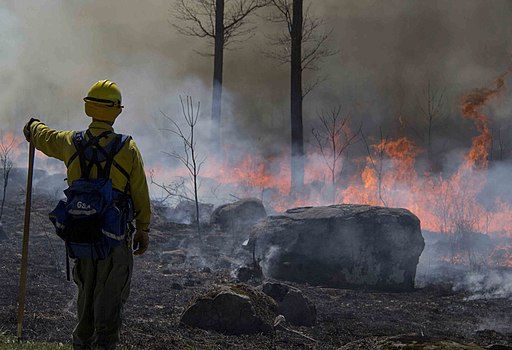
A vigilant watch: A firefighter monitors the prescribed fire, facing the dangers head-on as smoke rises from the burn area.
Tips for Choosing the Right Certification
Consider your career goals
Before choosing a certification, think about your long-term career goals. Do you want to work as a professional firefighter, or are you interested in volunteering as a firefighter? Different certifications may be required or preferred depending on your career path.
Research different certifications
There are a lot of different firefighting certifications available. It’s best to do some research and compare your options. It would help if you looked at what you need to do to get each certification and what responsibilities people have when they have that certification.
Consider your level of experience
Some certifications may be more suitable for individuals with more experience in the field, while others are for beginners. Consider your current level of experience and education when choosing a certification.
Get input from others
Talk to other firefighters or industry professionals to get their perspectives on the most valuable certifications for your career goals. You can also contact professional organizations or local fire departments for guidance.
Don’t be afraid to start small
If you’re just starting, it’s okay to start with a basic certification. You can then work your way up to more advanced certifications as you gain experience. Take the time to build a strong foundation and gain the necessary skills and knowledge.
What are the requirements to be a firefighter?
To be a firefighter, individuals typically need to meet certain requirements, which can vary by state or jurisdiction. Basic requirements include the following:
- Minimum age: Most states require firefighters to be at least 18 years old, although some may have a minimum age requirement of 21 or higher.
- Physical fitness: Firefighters need to be in good physical condition and able to pass a physical fitness test. This may include a written test, as well as a physical agility test that includes activities such as climbing stairs while carrying equipment and simulating fire hose operations.
- Education: Most firefighters have at least a high school diploma or equivalent, although some jurisdictions may require additional education, such as an associate’s or bachelor’s degree in a related field.
- Certification: Firefighters typically need to obtain one or more certifications, such as Firefighter 1 or 2, depending on the level of responsibility and the specific job duties.
- Drug test: Firefighters should pass a drug test as part of the hiring process.
- Background check: Most jurisdictions require firefighters to undergo a background check, including a criminal history check, as part of the hiring process.
Keep in mind that these are general requirements and specific requirements may vary by state or jurisdiction.
How long does it take to complete a certification?
The time it takes to complete a firefighter certification can vary depending on the specific certification and the individual’s experience and education level.
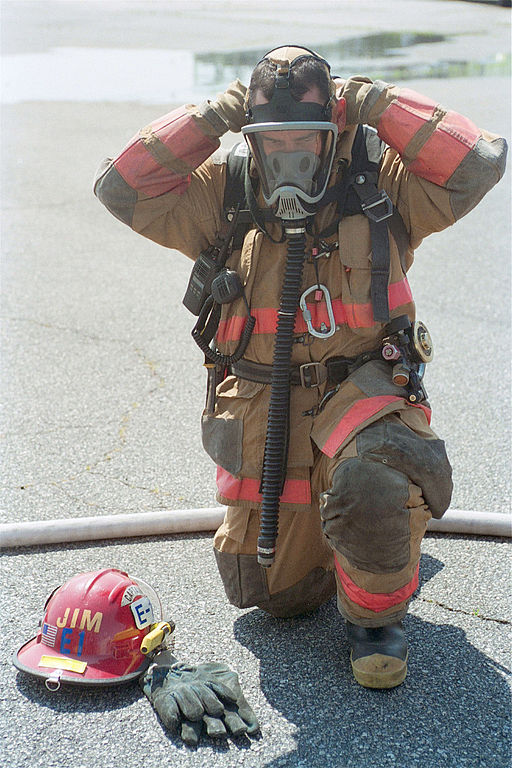
Here is an overview of the typical length of time it takes to complete some common firefighter certifications:
- Firefighter 1: This entry-level certification typically requires between 100 and 200 hours of firefighter training and can be completed in a few months.
- Firefighter 2: This intermediate-level certification typically requires an additional 200-400 hours of training beyond the Firefighter 1 certification and can take several months to complete.
- Certified Fire Inspector: This certification typically requires at least 80 hours of training.
- Basic Life Support: This certification typically requires a few days of training and can be renewed every two years.
- Rescue technician: The length of time it takes to complete this certification can vary depending on the specific training program and the individual’s level of experience. It may take several months to a year to complete this certification.
- Fire officer: This certification typically requires at least 200 hours of training and can take several months to complete.
- Nationally registered emergency medical technician (NREMT): This certification typically requires at least 150 hours of training and can be completed in a few months.
- Paramedic: This advanced certification typically requires at least 1,200 hours of training and can take several months to a year to complete.
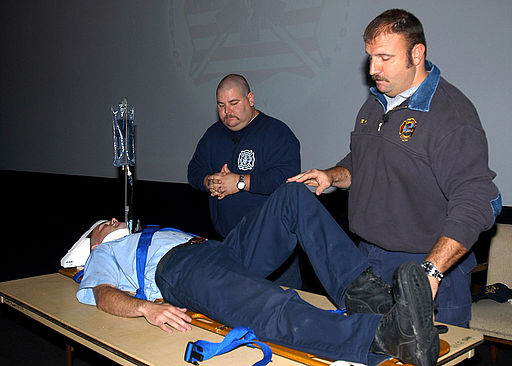
Firefighters/paramedics, Pat Kelly and Scott Mc Intyre of the Orlando Fire Department, simulate medical procedures for a trauma victim during a presentation by “Street Smart”, a group dedicated to educating the public on traffic safety.
Keep in mind that these are general estimates. The actual time it takes to complete a certification may vary depending on the specific program and the individual’s experience and education level. There may also be prerequisites or requirements that affect the duration of the certification process.
Required vs. volunteer certifications
Required certifications are those that are necessary for employment as a professional firefighter. They may vary by jurisdiction. State or local governments typically establish these certifications.
For example, some states may require firefighters to have a specific level of certification, such as Firefighter 1 or 2, to be eligible for employment. Required certifications may also be particular to the type of job or level of responsibility, such as a Fire Inspector certification for those working in fire prevention or a Fire Officer certification for those in leadership roles.
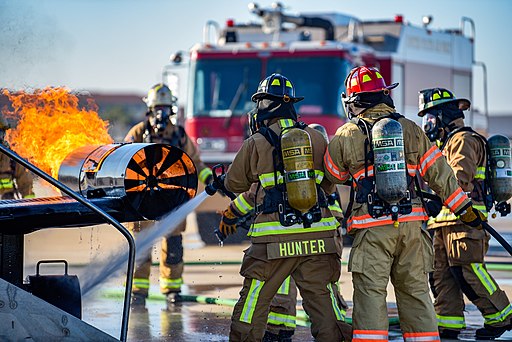
Firefighters battle simulated aircraft fires to maintain certifications and prepare for potential real-life scenarios.
On the other hand, there are volunteer certifications for individuals who want to volunteer as firefighters. These certifications may not be required, but they can help prepare individuals for the role of a volunteer firefighter and may be preferred by some organizations. Some states may have specific volunteer requirements, such as a certain level of state firefighter certification or training.
It’s best to ask about the specific requirements where you want to work as a firefighter. Some states or jurisdictions may have their own certification programs, while others may recognize certifications from national organizations or programs.
Resources for obtaining firefighting certifications
Here are a few resources for obtaining firefighting certifications:
National Fire Protection Association
The National Fire Protection Association (NFPA) is a leading organization providing resources and guidance on fire fighting and prevention. The NFPA offers a range of training and certification programs for individuals interested in obtaining a fire fighting certification.
The NFPA offers a range of other training and certification programs. These programs include ones for fire investigator, public fire and life safety educator, and hazardous materials technician.
National Fire Academy
The National Fire Academy offers a range of training and certification programs for firefighters, including the Fire and Emergency Services Higher Education (FESHE) program, which provides a national standard for higher education in fire and emergency services.
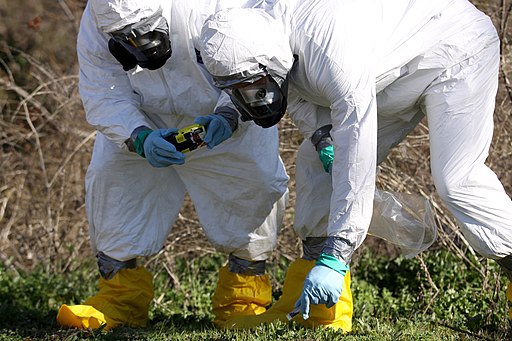
Firefighters on Marine Corps Base Camp Pendleton record Hazardous Material samples during a Field Training Exercise.
International Association of Fire Fighters (IAFF)
The IAFF is a professional organization that represents over 300,000 firefighters in the United States and Canada. The IAFF offers a range of training and certification programs, including the fire officer program and the hazardous materials technician program.
National Wildfire Coordinating Group (NWCG)
The National Wildfire Coordinating Group (NWCG) is a group of federal agencies that work together to manage wildland firefighting in the United States. The NWCG provides training and certification programs for wildland firefighters.
National Association of State Fire Marshals (NASFM)
The NASFM is a professional organization that represents state fire marshals and other fire protection professionals. The NASFM offers a range of training and certification programs, including the Certified Fire Inspector program and the Public Fire and Life Safety Educator program.
State or local fire departments
Many state and local fire departments offer training and certification programs for firefighters, either directly or through partnerships with other organizations. Contact your local fire service or check their website for more information.
If you aspire to become a firefighter, either as a career or as a volunteer, it is important to get certified. These certifications give you the skills and knowledge you need to do the job safely and effectively. You can find more information about firefighting certifications by looking at the resources mentioned or contacting your local fire department.


